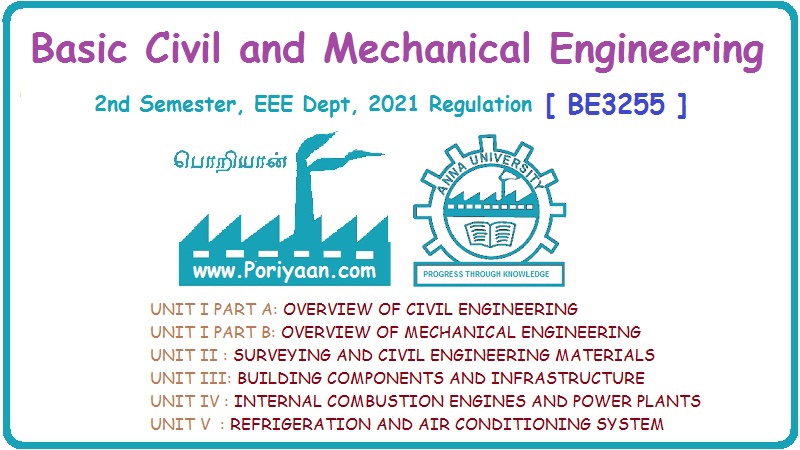Basic Civil & Mechanical Engineering: UNIT II: k. Cement concrete
Characteristics or properties of cement concrete
Mixing of concrete is done thoroughly so as to produce homogeneity.
CHARACTERISTICS / PROPERTIES OF CEMENT CONCRETE
1. Homogeneity
Mixing
of concrete is done thoroughly so as to produce homogeneity.
2. Work ability
It
is defined as the ease with which concrete can be compacted fully without
segregation and bleeding. Work ability depends on the quantity of water and
aggregates used.
3. Segregation
Segregation
means separation of coarser particles from the mix. It results in
non homogeneity of the concrete mix. Segregation results in honeycombing and
decrease in density and ultimately loss of strength of hardened concrete. To
avoid segregation, the concrete should not be thrown from a height.
4. Bleeding
Bleeding
refers to the appearance of water along with cement particles on the surface of
freshly laid concrete on compaction. [Compaction of the concrete is done either
by ramming or vibrating.] Bleeding occurs due to excessive compaction or excess
water present in the mix. Bleeding causes formation of pores in the concrete,
making it weak. Bleeding should be avoided by controlling quantity of water,
providing finer grading of fine aggregate and performing suitable optimum
compaction.
5. Compressive Strength
Concrete
should have high compressive strength, so that it can resist the heavy loads of
the structures.
6. Tensile Strength
Concrete
is weak in tensile strength. Therefore, steel reinforcement is provided in it
to withstand the tensile stress.
7. Reinforced Cement Concrete (R.C.C.)
Concrete
is weak in tension. Hence, steel reinforcement is provided to take up the
tensile stresses. This is known as Reinforced Cement Concrete (R.C.C.).
8. Minimum Shrinkage
On
hardening, the concrete should exhibit minimum shrinkage due to loss of water.
9. Density:
Concrete
must be adequately dense.
10. Process of Hardening
Concrete
hardens with age. The process of hardening should continue for a long time
after the concrete attains sufficient strength.
11. Hardness and Resistance to Abrasion
Concrete
should form a hard surface and provide enough resistance to abrasion.
12. Durability
Durability
of concrete refers to its resistance to deterioration due to weathering
(temperature or rain), fire, chemical attack, etc.
13. Free from Corrosion
Concrete
should be free from corrosion. Porous-concrete leads to the corrosion of steel reinforcement.
14. Porosity
Concrete
should not be porous. Porosity is caused in the concrete due to the presence of
voids formed during and after its placing.
15. Impermeability or Water Tightness
Impermeability
is the resistance of the concrete to the flow of water through the pore-spaces
in it. Concrete should have sufficient Impermeability or Water Tightness, so
that the moisture does not flow inside the structure and corrode the steel.
Corrosion of steel causes the structure to fail. Concrete is made water-tight
by using Hydro-phobic Cement.
16. Good Finish
Concrete
should provide the required good finish to the structure.
17. Dimensional Changes
In
concrete, dimensional changes are caused due to shrinkage of concrete, thermal
changes, elasticity and creep in concrete. The dimensional changes may induce
certain stresses in the concrete leading to its cracking.
Basic Civil & Mechanical Engineering: UNIT II: k. Cement concrete : Tag: : - Characteristics or properties of cement concrete
Related Topics
Related Subjects
Basic Civil and Mechanical Engineering
BE3255 2nd Semester 2021 Regulation | 2nd Semester EEE Dept 2021 Regulation
